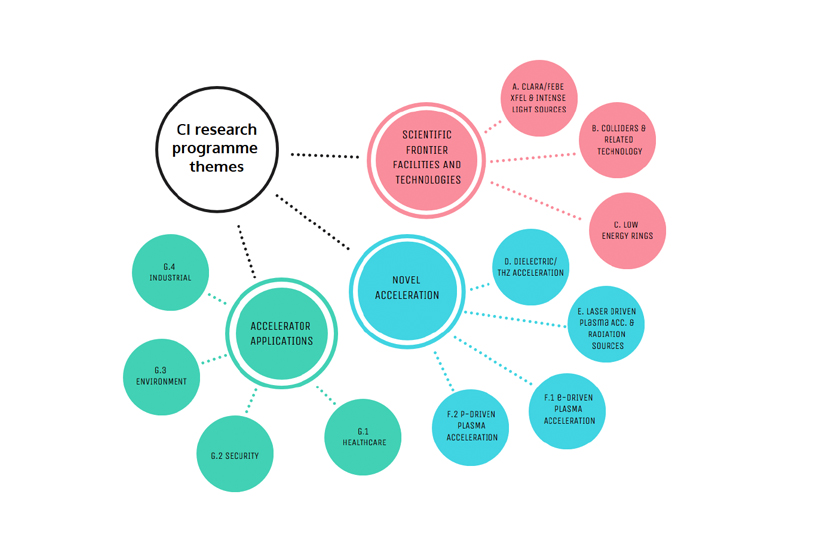The principal objective of the CI is to be a fully sustainable organization capable of delivering worldclass research and development in particle accelerator science & technology that is well aligned to national science policy and the strategic requirements of the partner universities and UKRI/STFC. This implies an obligation, in the short and long term, to enable the research of the UK’s acceleratorbased particle & nuclear physics communities, as well as the research of the UK’s advanced light source and neutron user communities. It also necessitates the application of accelerators for societal and economic benefits.
The shorter term needs of the research communities that we enable are met by the implementation of conventional RF based accelerator technologies at a selection of scientific frontier facilities in the UK and overseas. By contributing to HL-LHC at CERN and PIP-II at Fermilab we are effectively enabling the research of the UK’s entire hadron collider community and most of its neutrino physicists which together account for the vast majority of particle physics activity in the country. Parts of the nuclear physics community will also be enabled by our potential contributions to EIC at Brookhaven. The upgrades of the Diamond Light Source and the ISIS neutron facility at RAL as well as our contributions to Swiss-FEL and ESS (ASTeC only) create immense opportunities for the many areas of science that utilise advanced light sources and neutron beams, whilst an advanced X-ray FEL facility in the UK is at the forefront of our longer-term ambitions. Our work on enabling technologies like X-band RF, SRF, synchronisation etc., is poised to bear fruit in the near future.
The broad-based programme in novel acceleration techniques is designed to address the longer term needs of all of the communities that we enable. Our strategy in this area is to pursue several options simultaneously because each one has the potential to address different user requirements such as radiation types, beam energies, brightness, intensity and compactness. Furthermore, some of these techniques may be more suited to beam manipulation (deflection, de-chirping) than acceleration. To these ends we are investigating laser and particle driven plasma wakefield electron/ion accelerators and radiation sources as well as a number of different dielectric lined cavity structures driven by lasers or THz radiation sources.
The application of accelerators programme is intended to address some of the global grand challenge themes, especially in the areas of healthcare, security and the environment. In the shortterm conventional RF based techniques will be to the fore but we are also beginning to see a growing importance for solutions based on novel acceleration techniques in some applications. By far the most active application area is advanced radiotherapy where we are engaged in the further development of X-ray and proton beam therapy instruments and in the establishment of a new technique based on very high as well as very low energy electrons. We are also responding to UKRI priorities with work on radiotherapy and environmental applications in lower-middle income countries.
Because of the limited resources available, major efforts will be restricted to a few areas to ensure international leading output, while maintaining a range of broader, complementary, accelerator research capabilities, which will allow engagement in international projects and enable the development of a unique UK brand in accelerator science. We strive for a healthy balance of leadership roles in international projects and national projects, which is absolutely vital for a sustainable accelerator R&D community in the UK, for realizing international lighthouse projects and to attract international funding streams into the UK. This will be articulated through focusing on activities that are chosen for their scientific and technical merit, and societal importance.
Key performance indicators include research excellence, 4/3 REF publications in high impact factor journals, delivery of hardware and software to facilities, impact case studies, research income generation, industrial engagement, collaborations and leadership. A robust and agile management structure will guide the effective use of resources and manpower. This will enable delivery and enhancement of strategically important facilities for UK science and industry, while exploiting the opportunities presented by devolution and regional investment, which is important to CI strategy.
To ensure that the UK has the capacity to meet the challenges of rapidly developing accelerator technologies, we will train the next generation of accelerator experts, and inspire school students and the general public with an engagement programme that highlights the science that we both perform and enable, while also demonstrating how we are addressing the global challenges in health, security, energy, manufacturing and the environment.
The principal research activities of the Institute are divided amongst three organisational pillars: scientific frontier facilities & underpinning technologies (to enhance basic knowledge of the structure of matter and the evolution of the universe), novel acceleration techniques (to lay the foundations for innovations in accelerator technology) and applications of accelerators (to address global challenges and enhance the health & wealth of the nation). The frontier facilities pillar is composed of three complementary themes: (A) CLARA/XFEL & intense light sources, (B) colliders & related technology and (C) low-energy rings. The novel techniques pillar is also composed of three complementary themes: (D) dielectric/THz & other structures (E) laser driven plasma and (F) particle driven plasma. The third pillar and seventh theme (G) encompasses accelerator applications addressing global challenges.

